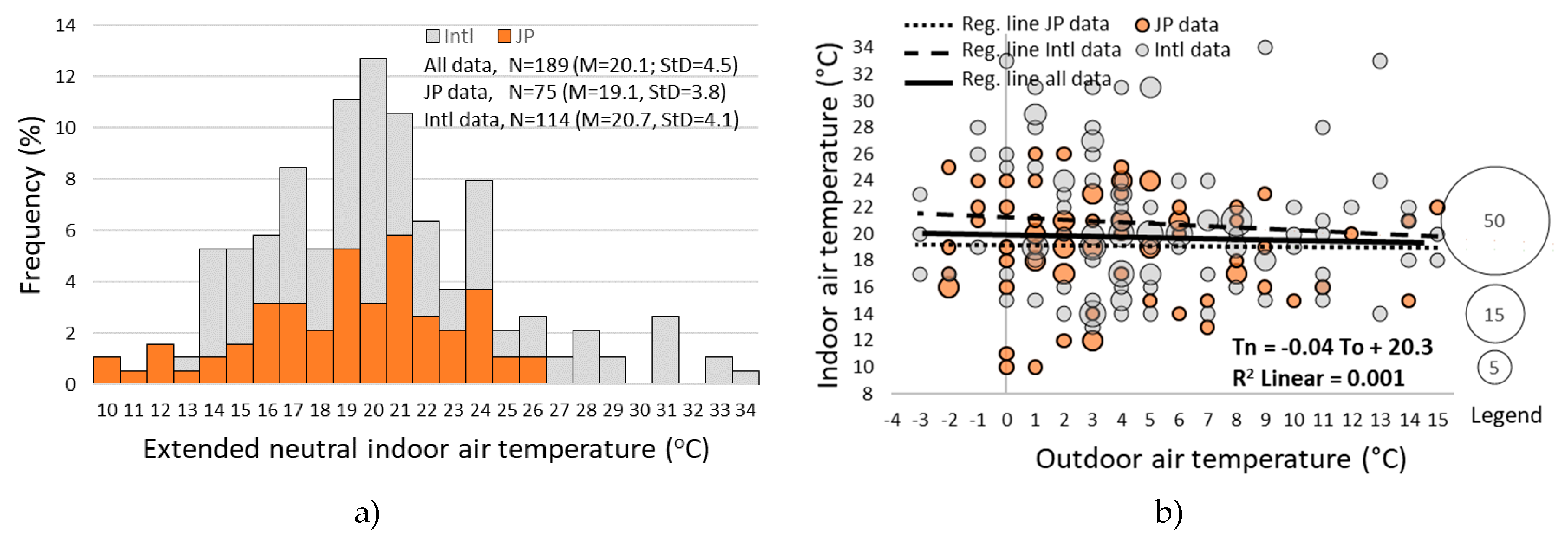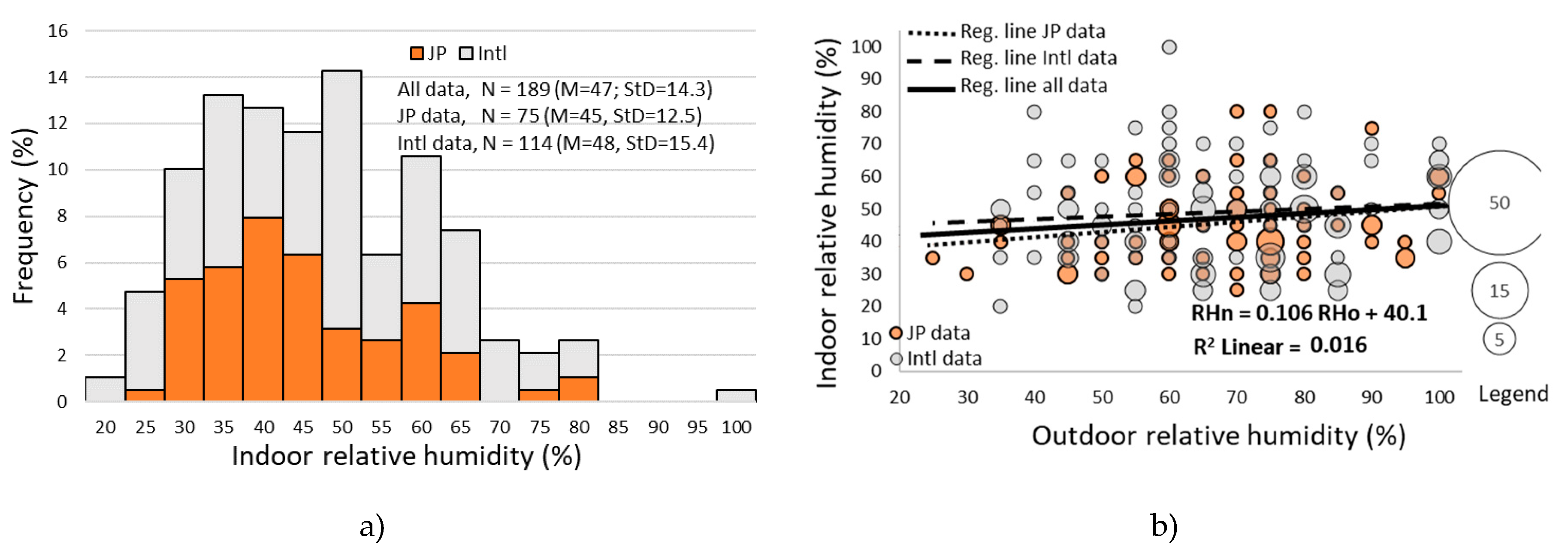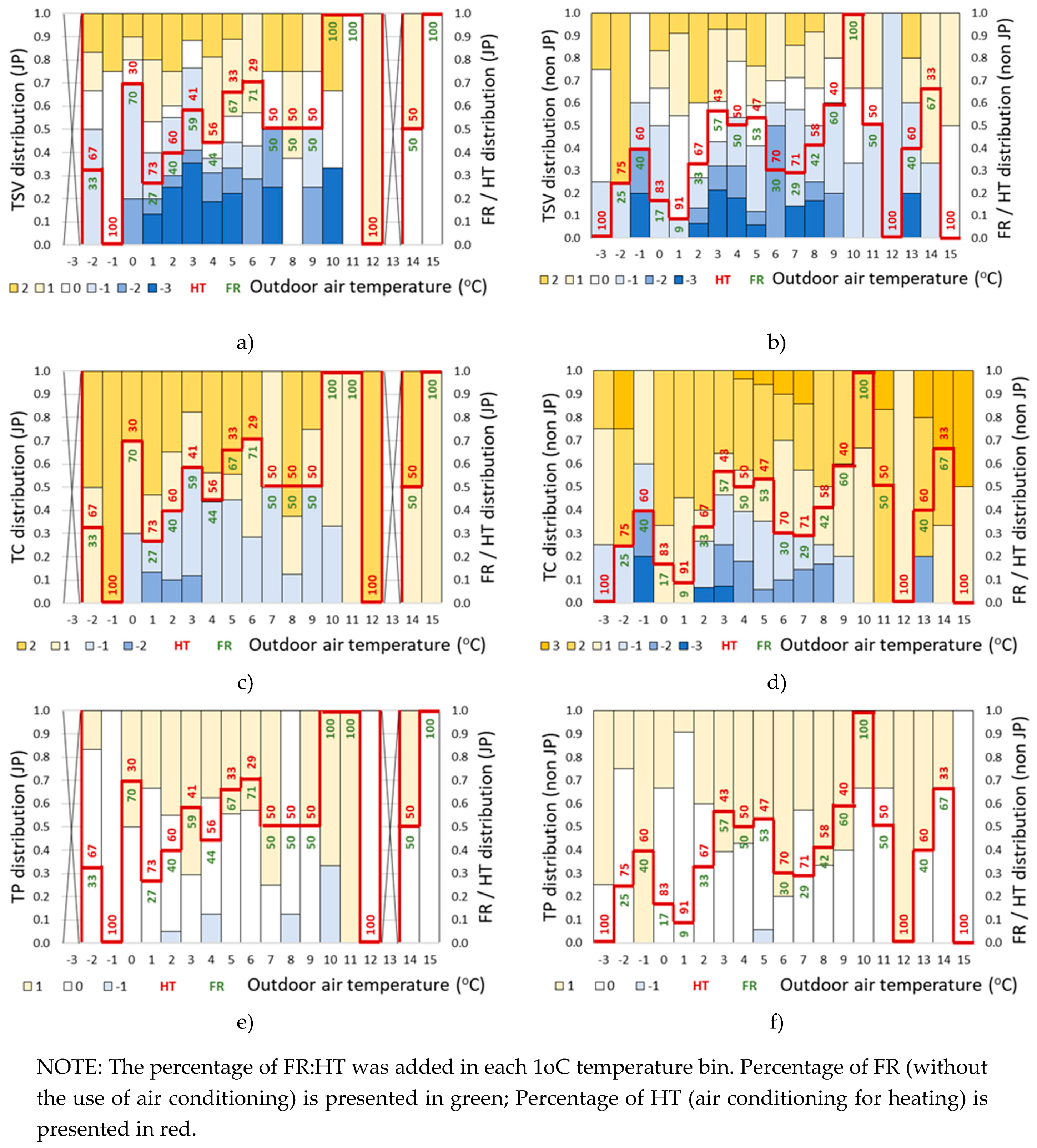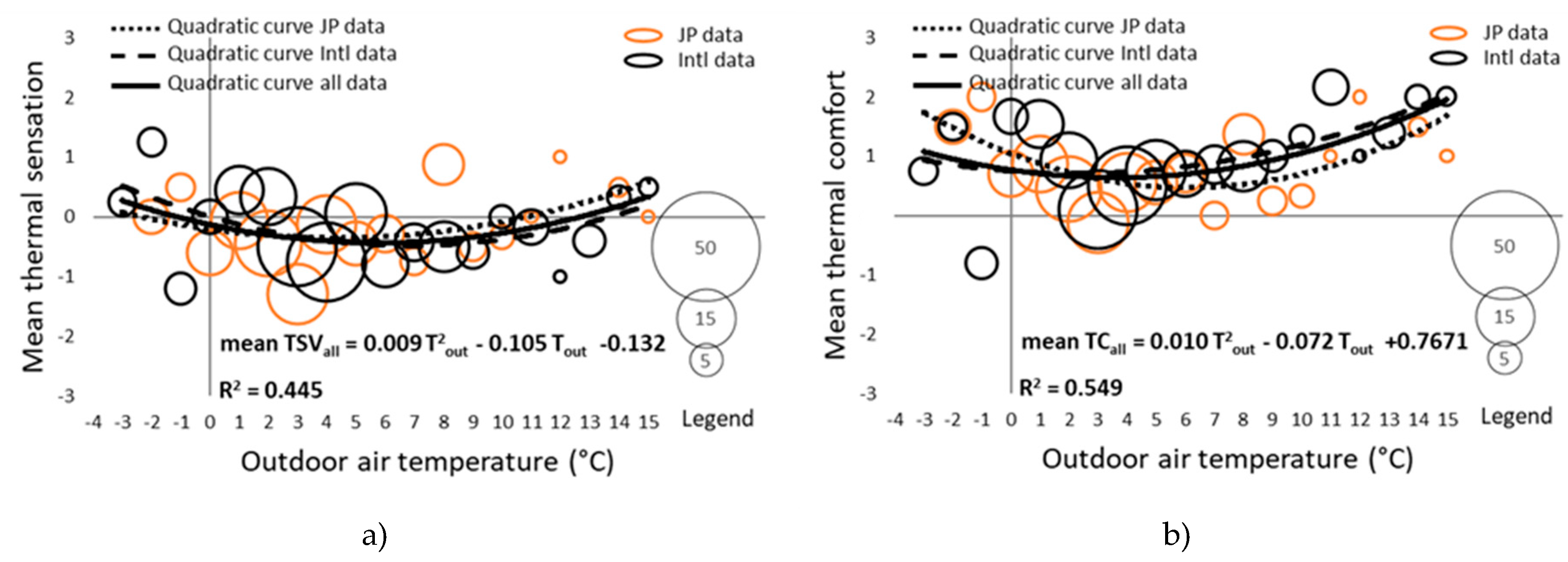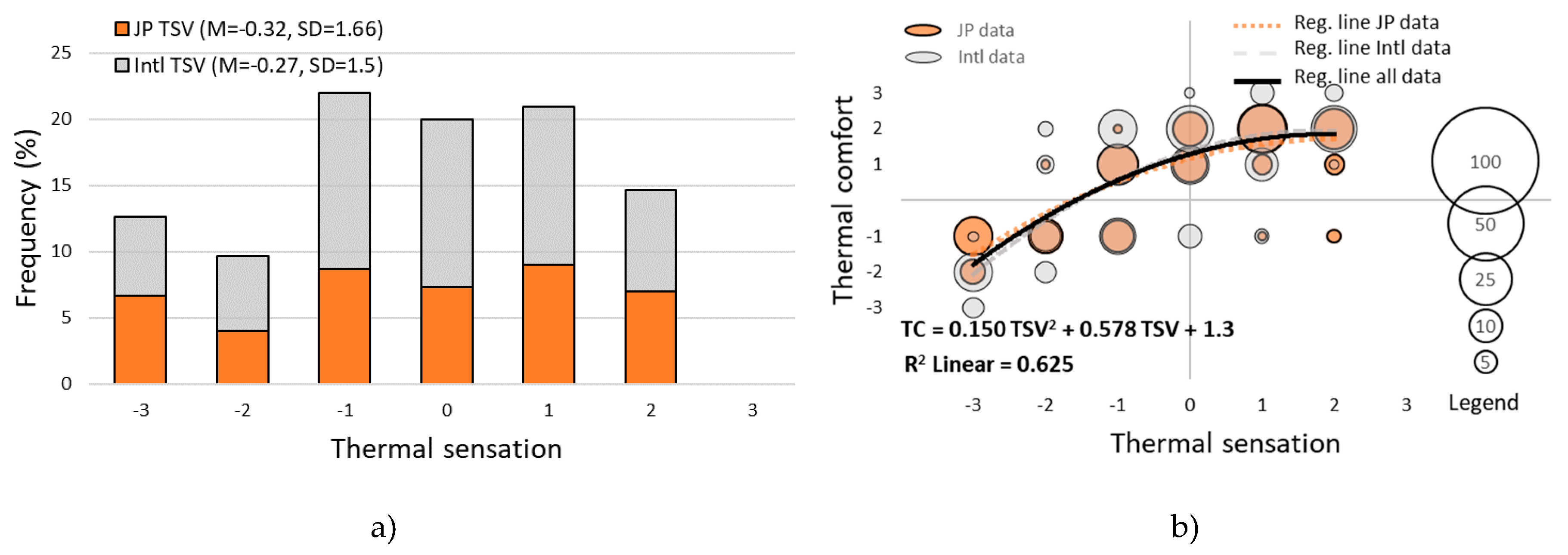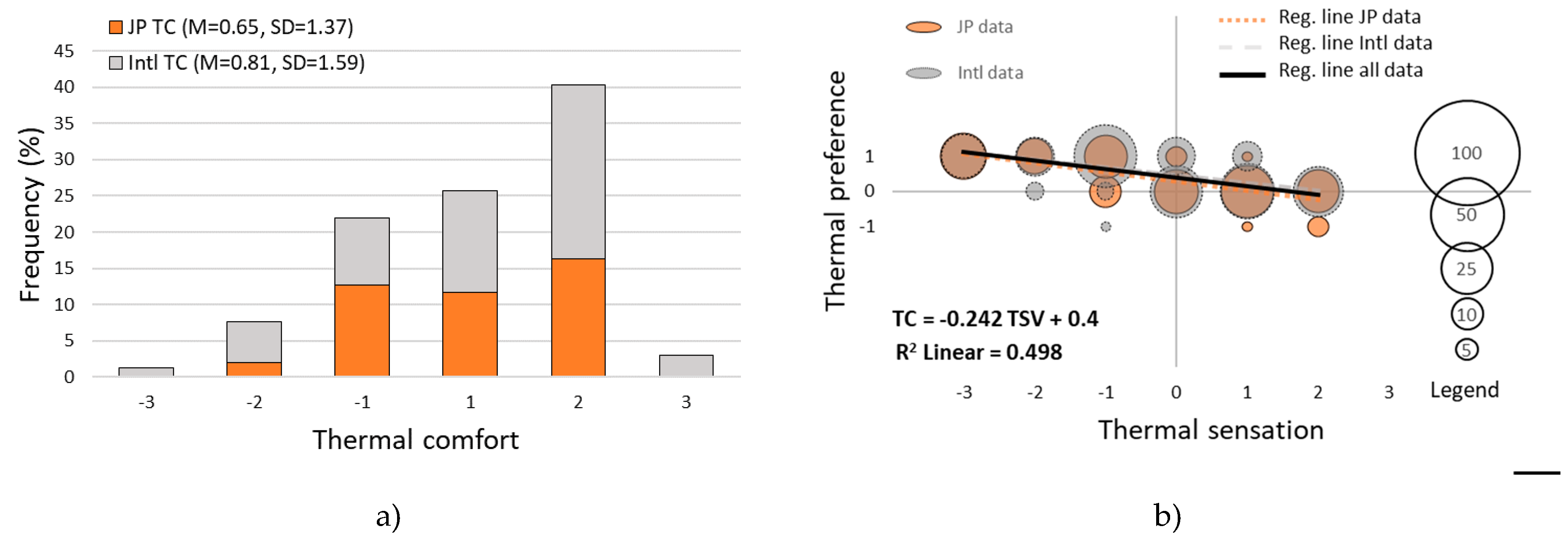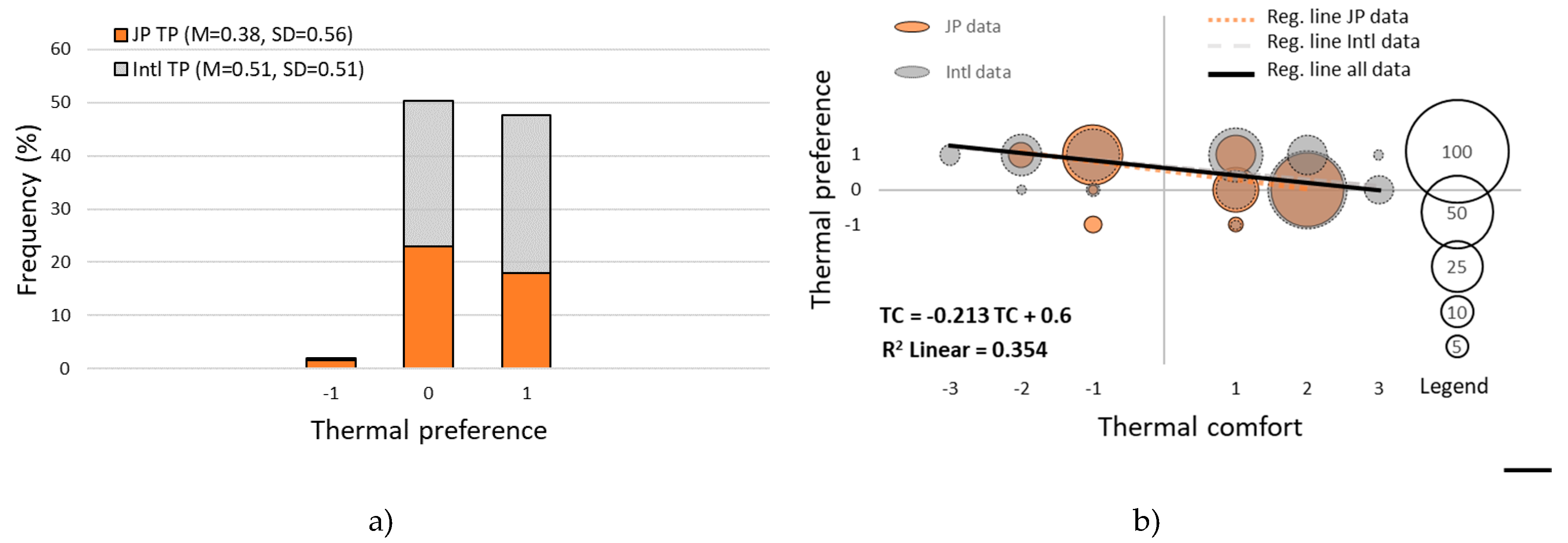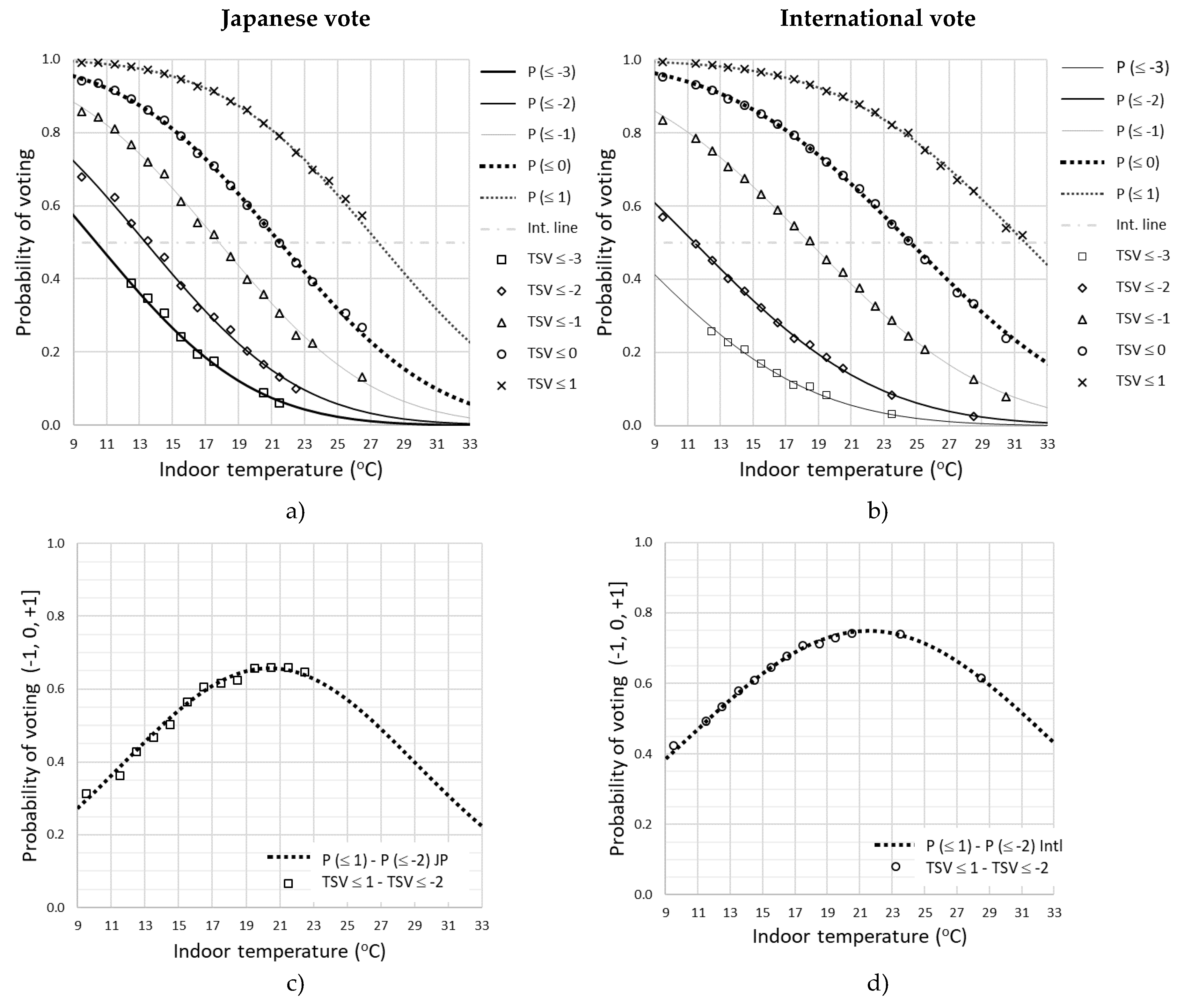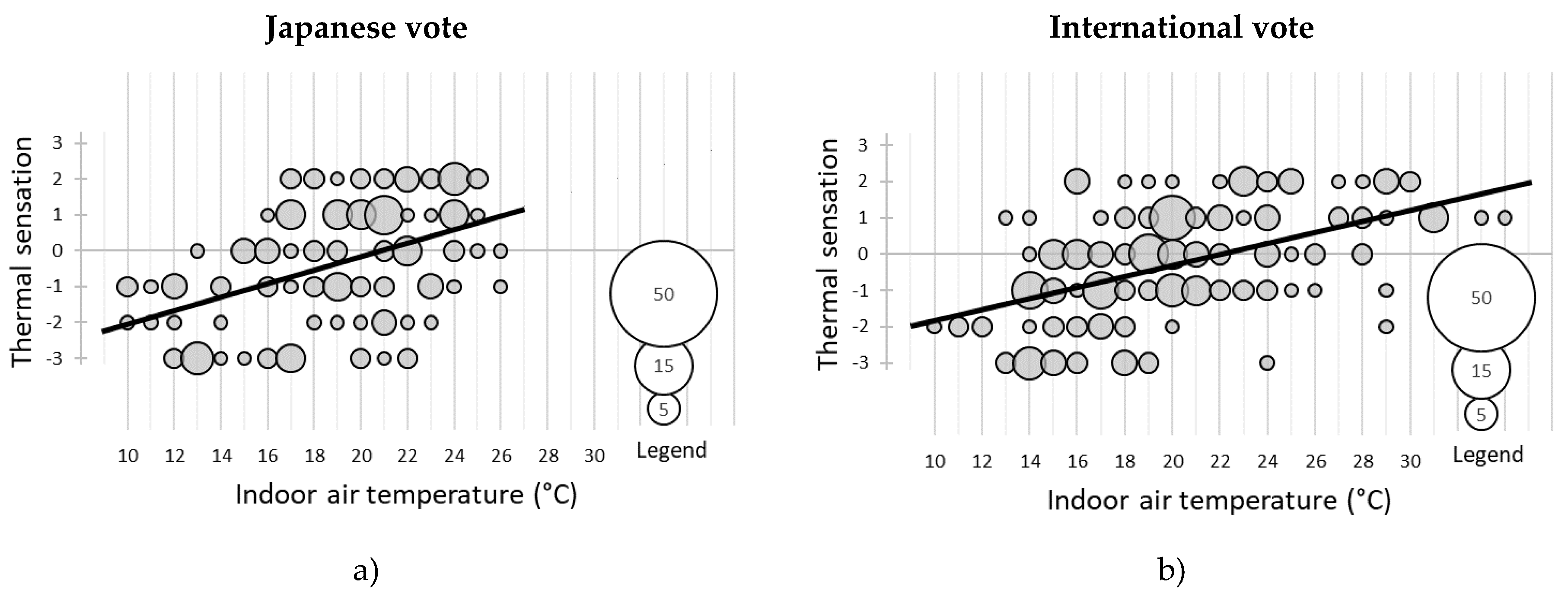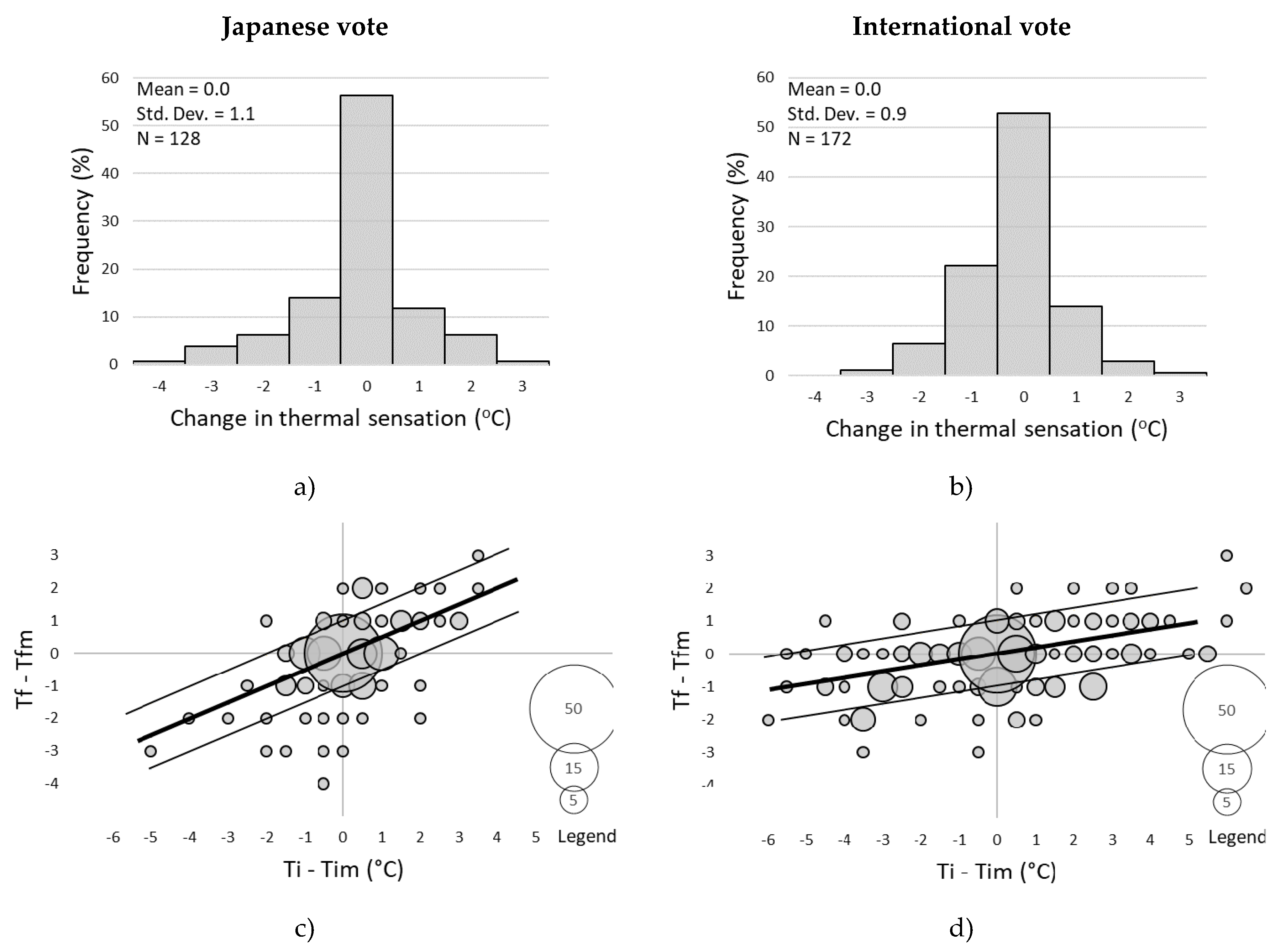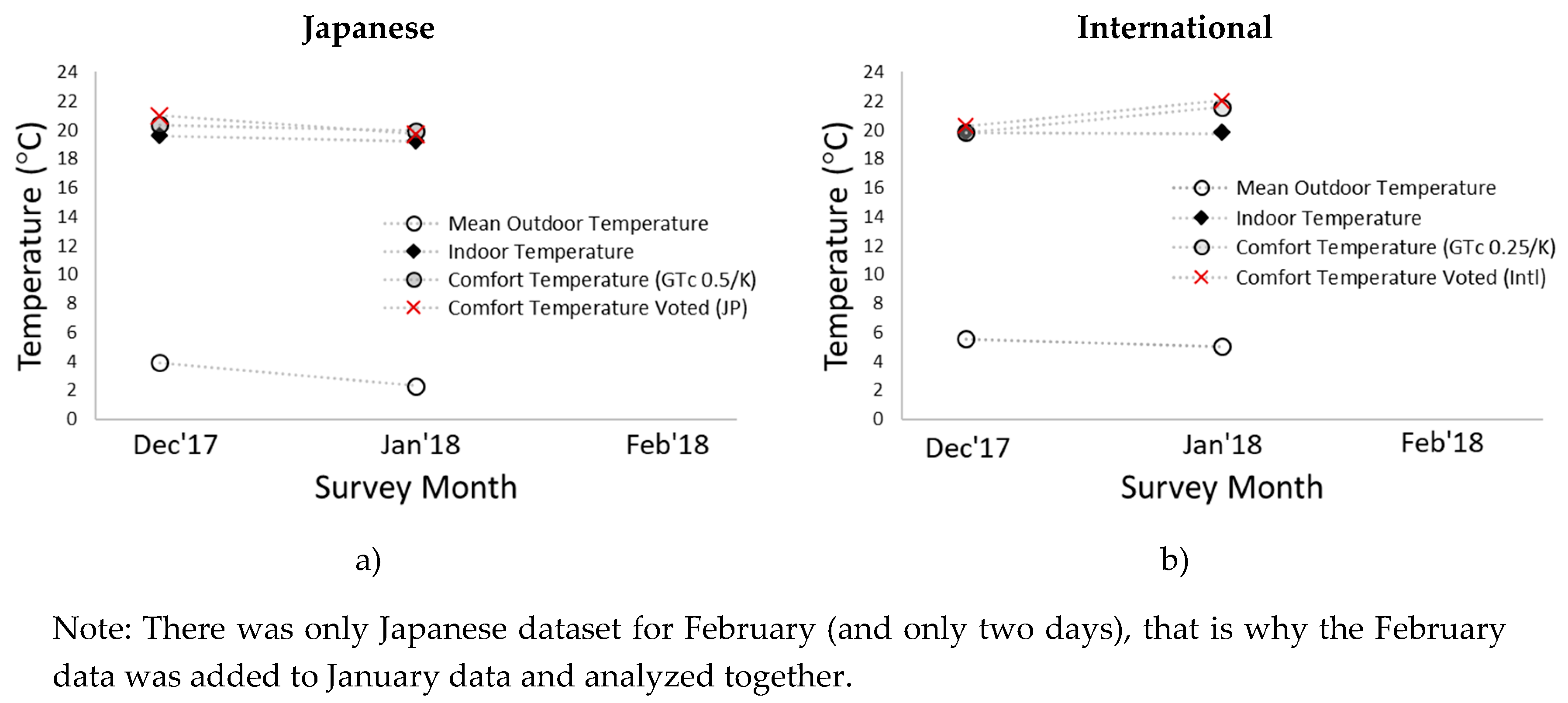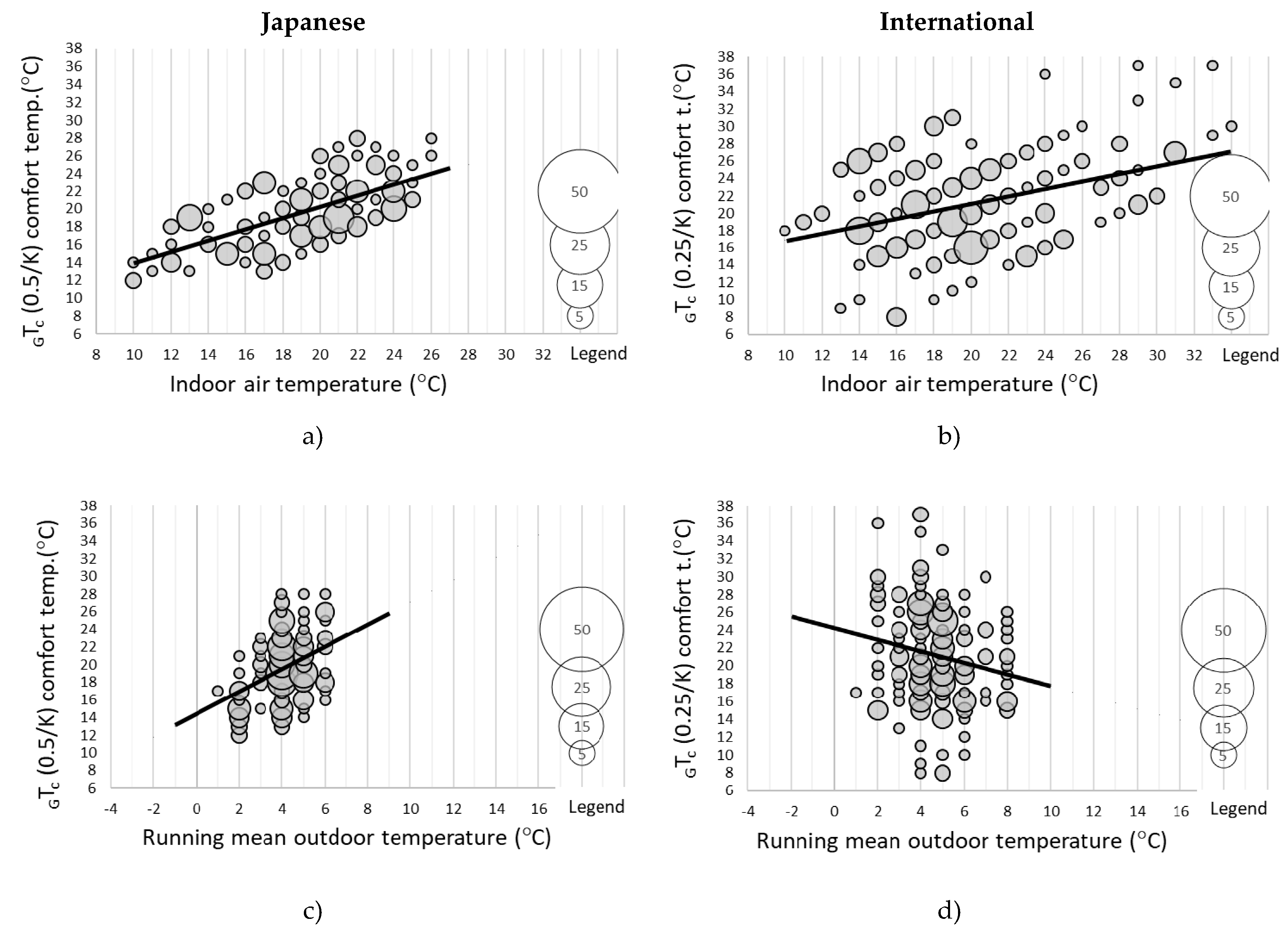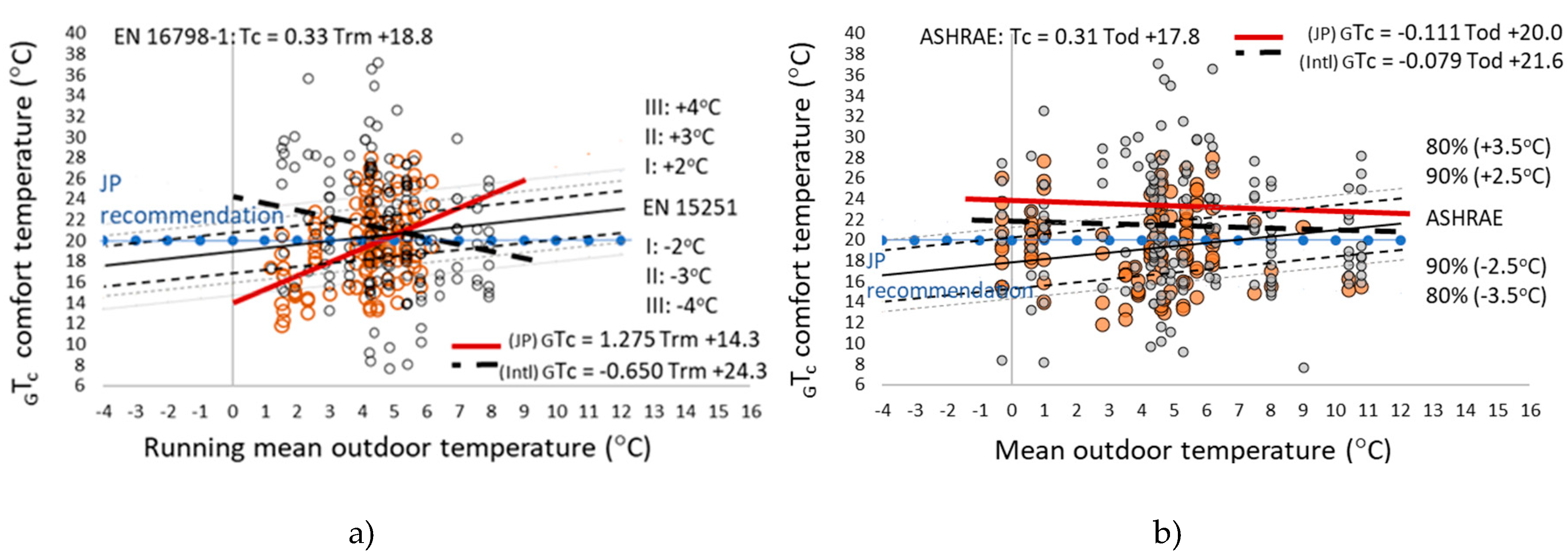Author Contributions
Conceptualization (V.D., K.T., Y.N.); Methodology (V.D., K.T., Y.N.), Software (V.D.), Formal Analysis (V.D.), Investigation (V.D.), Resources (K.T., Y.N.), Data Curation (V.D.), Writing—Original Draft Preparation (V.D.), Writing—Review & Editing (V.D.), Visualization (V.D.), Supervision (K.T., Y.N.), Project Administration (K.T., Y.N.), Funding Acquisition (K.T., Y.N.).
Figure 1.
Toyohashi, Japan. (a) Location; (b) climate. Data from JMA WMO ID: 47654—min, max and mean air temperature and relative humidity for winter season 2017–2018.
Figure 1.
Toyohashi, Japan. (a) Location; (b) climate. Data from JMA WMO ID: 47654—min, max and mean air temperature and relative humidity for winter season 2017–2018.
Figure 2.
Week 1—Events schedule (**Each volunteer participated three non-sequential weeks).
Figure 2.
Week 1—Events schedule (**Each volunteer participated three non-sequential weeks).
Figure 3.
Population sample—Number of votes: Distribution relative to age, sex, nationality, race and BMI. ** ML (Malaysian); V (Vietnamese); IND (Indonesian); BA (Bangladeshi); MX (Mexican); G (German); BR (Brazilian); H (Hungarian); R (Russian).
Figure 3.
Population sample—Number of votes: Distribution relative to age, sex, nationality, race and BMI. ** ML (Malaysian); V (Vietnamese); IND (Indonesian); BA (Bangladeshi); MX (Mexican); G (German); BR (Brazilian); H (Hungarian); R (Russian).
Figure 4.
Indoor and outdoor temperature at TSV (−1, 0, +1): (a) Frequency percentage distribution of neutral indoor air temperature; (b) correlation between indoor and outdoor air temperature at the vote.
Figure 4.
Indoor and outdoor temperature at TSV (−1, 0, +1): (a) Frequency percentage distribution of neutral indoor air temperature; (b) correlation between indoor and outdoor air temperature at the vote.
Figure 5.
Indoor and outdoor relative humidity at TSV (−1, 0, +1): (a) Frequency percentage distribution of neutral indoor relative humidity; (b) correlation between indoor and outdoor relative humidity at the vote.
Figure 5.
Indoor and outdoor relative humidity at TSV (−1, 0, +1): (a) Frequency percentage distribution of neutral indoor relative humidity; (b) correlation between indoor and outdoor relative humidity at the vote.
Figure 6.
Indoor and outdoor absolute humidity at TSV (−1, 0, +1): (a) Frequency percentage distribution of neutral indoor absolute humidity; (b) correlation between indoor and outdoor absolute humidity at the vote.
Figure 6.
Indoor and outdoor absolute humidity at TSV (−1, 0, +1): (a) Frequency percentage distribution of neutral indoor absolute humidity; (b) correlation between indoor and outdoor absolute humidity at the vote.
Figure 7.
Frequency distributions of thermal responses relative to outdoor temperature and the use of air-conditioning; (a) Japanese TSV: Tout; (b) Non-Japanese TSV: Tout; (c) Japanese TC: Tout; (d) Non-Japanese TC: Tout; (e) Japanese TP: Tout; (f) Non-Japanese TP: Tout.
Figure 7.
Frequency distributions of thermal responses relative to outdoor temperature and the use of air-conditioning; (a) Japanese TSV: Tout; (b) Non-Japanese TSV: Tout; (c) Japanese TC: Tout; (d) Non-Japanese TC: Tout; (e) Japanese TP: Tout; (f) Non-Japanese TP: Tout.
Figure 8.
Relationship between mean values of thermal responses to the outdoor temperature. (a) Mean TSV: Tout; (b) mean TC: Tout.
Figure 8.
Relationship between mean values of thermal responses to the outdoor temperature. (a) Mean TSV: Tout; (b) mean TC: Tout.
Figure 9.
The frequency distributions and correlation between thermal responses; (a) Distribution of TSV; (b) correlation TC: TSV.
Figure 9.
The frequency distributions and correlation between thermal responses; (a) Distribution of TSV; (b) correlation TC: TSV.
Figure 10.
The frequency distributions and correlation between thermal responses; (a) Distribution of TC; (b) correlation TP: TSV.
Figure 10.
The frequency distributions and correlation between thermal responses; (a) Distribution of TC; (b) correlation TP: TSV.
Figure 11.
The frequency distributions and correlation between thermal responses; (a) Frequency distribution of TP; (b) correlation TP: TC.
Figure 11.
The frequency distributions and correlation between thermal responses; (a) Frequency distribution of TP; (b) correlation TP: TC.
Figure 12.
Graphical representation of probit analysis: (a) Probability of voting a certain TSV for Japanese subjects; (b) probability of voting a certain TSV for international subjects; (c) probability of voting within the “extended neutral range” of TSV scale—from −1 to +1 for Japanese subjects; (d) probability of voting within the “extended neutral range” of TSV scale—from −1 to +1 for international subjects. Note: Marker points represent the actual proportion of voting.
Figure 12.
Graphical representation of probit analysis: (a) Probability of voting a certain TSV for Japanese subjects; (b) probability of voting a certain TSV for international subjects; (c) probability of voting within the “extended neutral range” of TSV scale—from −1 to +1 for Japanese subjects; (d) probability of voting within the “extended neutral range” of TSV scale—from −1 to +1 for international subjects. Note: Marker points represent the actual proportion of voting.
Figure 13.
Thermal sensation votes: (a) The correlation between TSV and indoor air temperature at the vote for Japanese subjects; (b) the correlation between TSV and indoor air temperature at the vote for international subjects.
Figure 13.
Thermal sensation votes: (a) The correlation between TSV and indoor air temperature at the vote for Japanese subjects; (b) the correlation between TSV and indoor air temperature at the vote for international subjects.
Figure 14.
Room-wise day-survey averages (a) frequency distribution of the Japanese vote; (b) frequency distribution of international vote; (c) regression of the day surveys from the Japanese vote; (d) regression of the day surveys from the international vote. Note: Outer lines indicate the residual standard deviation.
Figure 14.
Room-wise day-survey averages (a) frequency distribution of the Japanese vote; (b) frequency distribution of international vote; (c) regression of the day surveys from the Japanese vote; (d) regression of the day surveys from the international vote. Note: Outer lines indicate the residual standard deviation.
Figure 15.
Comparing mean temperatures in each survey month (a) Japanese dataset; (b) international dataset.
Figure 15.
Comparing mean temperatures in each survey month (a) Japanese dataset; (b) international dataset.
Figure 16.
Griffiths comfortable temperature: (a) Frequency distribution of the calculated Japanese comfortable temperature; (b) frequency distribution of the calculated international comfortable temperature.
Figure 16.
Griffiths comfortable temperature: (a) Frequency distribution of the calculated Japanese comfortable temperature; (b) frequency distribution of the calculated international comfortable temperature.
Figure 17.
Griffiths comfortable temperature at 0.5/K (a) regression with indoor air temperature for Japanese subjects; (b) regression with indoor air temperature for non-Japanese subjects; (c) regression with a running mean outdoor air temperature for Japanese subjects; (d) regression with a running mean outdoor air temperature for non-Japanese subjects.
Figure 17.
Griffiths comfortable temperature at 0.5/K (a) regression with indoor air temperature for Japanese subjects; (b) regression with indoor air temperature for non-Japanese subjects; (c) regression with a running mean outdoor air temperature for Japanese subjects; (d) regression with a running mean outdoor air temperature for non-Japanese subjects.
Figure 18.
Comparison of comfortable temperature with standards: (a) EN 16798-1 and (b) ASHRAE.
Figure 18.
Comparison of comfortable temperature with standards: (a) EN 16798-1 and (b) ASHRAE.
Table 1.
Measuring devices.
Table 1.
Measuring devices.
| Name | Type | Parameter | Range and Accuracy | Image | Notes |
|---|
| Thermo-hygrometer | TR-74Ui
ISA-3151 sensor
THA-3151 sensor | Air temperature
Relative humidity
Illuminance | 0–55 °C (±0.5 °C)
10–95 %RH (±5%)
0–130klx (±5%) | ![Buildings 09 00213 i001 Buildings 09 00213 i001]() | Continuous measurement
(1-min interval) |
| Air Flow Transducer | 6332D
(KANOMAX probe/VR-71 data logger) | Air Speed | 0.1~25.0 m/s (±3%) | ![Buildings 09 00213 i002 Buildings 09 00213 i002]() | Continuous measurement
(1-min interval) |
Table 2.
Descriptive statistics of the collected data at times of vote.
Table 2.
Descriptive statistics of the collected data at times of vote.
| | Ti (°C) | Tout (°C) | Tod (°C) | Trm (°C) | RHi (%) | RHo (%) | Va (m/s) ** | AHi (kg/kgDA) | AHo (kg/kgDA) | Icl (clo) | M (met) | BMI (kg/m2) |
|---|
| Min | 9.8 | −2.9 | −0.3 | 1.2 | 21 | 25 | 0.001 | 0.003 | 0.001 | 0.36 | 1.0 | 19.4 |
| Max | 33.7 | 14.8 | 10.8 | 7.9 | 98 | 100 | 0.425 | 0.011 | 0.009 | 2.11 | 2.7 | 27.8 |
| Mean | 19.6 | 4.2 | 4.7 | 4.4 | 47 | 66 | 0.032 | 0.007 | 0.003 | 0.63 | 1.3 | 22.2 |
| St. D | 4.7 | 3.7 | 2.6 | 1.5 | 14 | 18 | 0.063 | 0.002 | 0.001 | 0.23 | 0.4 | 2.0 |
Table 3.
Correlation coefficients.
Table 3.
Correlation coefficients.
| | All Data Points (N = 189) | Japanese (N = 75) | International (N = 114) |
|---|
| r | a | β | R2 | p | r | a | β | R2 | p | r | a | β | R2 | p |
|---|
| Tn: Tout | −0.04 | −0.040 | 20.3 | 0.001 | 0.619 | −0.02 | −0.022 | 19.2 | 0.001 | 0.843 | −0.09 | −0.102 | 21.2 | 0.007 | 0.360 |
| Tn: Tod | −0.07 | −0.106 | 20.6 | 0.005 | 0.351 | −0.14 | −0.208 | 20.0 | 0.020 | 0.222 | −0.12 | −0.192 | 21.8 | 0.013 | 0.225 |
| Tn: Trm | 0.07 | 0.189 | 19.2 | 0.004 | 0.370 | 0.40 | 1.169 | 14.4 | 0.163 | <0.001 | −0.13 | −0.379 | 22.5 | 0.017 | 0.172 |
| RHn:RHo | 0.13 | 0.106 | 40.1 | 0.016 | 0.082 | 0.20 | 0.149 | 35.4 | 0.041 | 0.082 | 0.09 | 0.077 | 43.2 | 0.008 | 0.352 |
| AHn:AHo | 0.51 | 0.562 | 0.005 | 0.261 | <0.001 | 0.37 | 0.414 | 0.005 | 0.139 | <0.001 | 0.54 | 0.556 | 0.005 | 0.288 | <0.001 |
Table 4.
Percentage of thermal responses for each scale relative to nationality (Japanese: N = 128; international: N = 172).
Table 4.
Percentage of thermal responses for each scale relative to nationality (Japanese: N = 128; international: N = 172).
| Scale | Thermal Sensation (TSV) % | Thermal Comfort (TC) % | Thermal Preference (TP) % | Thermal Acceptability (TA)% |
|---|
| | | JP | Intl | | JP | Intl | | JP | Intl | | JP | Intl |
|---|
| 3 | H | - | - | VCO | - | 5.2 | | | | | | |
| 2 | W | 16.4 | 13.4 | CO | 38.3 | 41.9 | | | | | | |
| 1 | SW | 21.1 | 20.9 | SCO | 27.3 | 24.4 | PW | 42.2 | 51.7 | UNC | 8.6 | 11.6 |
| 0 | N | 17.2 | 22.1 | | | | PN | 53.9 | 47.7 | ACC | 91.4 | 88.4 |
| −1 | SC | 20.3 | 23.3 | SUC | 29.7 | 16.3 | PC | 3.9 | 0.6 | | | |
| −2 | C | 9.4 | 9.9 | UC | 4.7 | 9.9 | | | | | | |
| −3 | CC | 15.6 | 10.5 | VUC | - | 2.3 | | | | | | |
Table 5.
Correlation between mean thermal responses and outdoor temperature.
Table 5.
Correlation between mean thermal responses and outdoor temperature.
| | All Data Points | Japanese | International |
|---|
| TSVall | TCall | TPall | TAall | TSVJP | TCJP | TPJP | TAJP | TSVall | TCall | TPall | TAall |
|---|
| r | 0.06 | 0.52 | −0.23 | −0.23 | 0.31 | 0.07 | 0.04 | −0.35 | −0.17 | 0.48 | −0.14 | −0.19 |
| p | −0.406 | 0.087 | −0.618 | −0.618 | −0.201 | −0.429 | −0.451 | −0.712 | −0.577 | <0.05 | −0.556 | −0.592 |
| Quad.R2 | 0.45 | 0.55 | 0.11 | 0.17 | 0.22 | 0.37 | 0.13 | 0.21 | 0.24 | 0.33 | 0.05 | 0.10 |
Table 6.
Correlation between thermal responses.
Table 6.
Correlation between thermal responses.
| | All Data Points (N = 300) | Japanese (N = 128) | International (N = 172) |
|---|
| r | a | β | R2 | p | r | a | β | R2 | p | r | a | β | R2 | p |
|---|
| TC: TSV | 0.75 | 0.718 | 0.9 | 0.565 | <0.001 | 0.79 | 0.650 | 0.9 | 0.621 | <0.001 | 0.74 | 0.778 | 1.0 | 0.542 | <0.001 |
| TP: TSV | −0.71 | −0.242 | 0.4 | 0.498 | <0.001 | −0.78 | −0.265 | 0.3 | 0.615 | <0.001 | −0.65 | −0.222 | 0.5 | 0.421 | <0.001 |
| TA: TSV | −0.50 | −0.098 | 0.1 | 0.253 | <0.001 | −0.36 | −0.061 | 0.1 | 0.130 | <0.001 | −0.61 | −0.131 | 0.1 | 0.376 | <0.001 |
| TP: TC | −0.60 | −0.213 | 0.6 | 0.354 | <0.001 | −0.64 | −0.262 | 0.6 | 0.409 | <0.001 | −0.59 | −0.191 | 0.7 | 0.348 | <0.001 |
| TA:TC | −0.59 | −0.119 | 0.2 | 0.342 | <0.001 | −0.45 | −0.093 | 0.1 | 0.204 | <0.001 | −0.67 | −0.135 | 0.2 | 0.444 | <0.001 |
| TA:TP | 0.30 | 0.172 | 0.0 | 0.092 | <0.001 | 0.23 | 0.119 | 0.0 | 0.057 | <0.05 | 0.35 | 0.217 | 0.0 | 0.120 | <0.001 |
Table 7.
Summary of Chi-square results: Dependence of TSV, TC, TP and TA on sub-divisions.
Table 7.
Summary of Chi-square results: Dependence of TSV, TC, TP and TA on sub-divisions.
| | Sub-Division | n | df | χ2 Critical | χ2 | p | Estimated by Regression * (°C) | δT (°C) |
|---|
| TSV | AC on: AC off | 165: 135 | 5 | 11.07 | 43.34 | <0.001 | | | |
| | Male: Female | 216: 84 | 12.93 | <0.05 | | | |
| TC | AC on: AC off | 165: 135 | 5 | 11.07 | 29.79 | <0.001 | | | |
| | GSD: Kaikan | 147: 153 | 15.25 | <0.001 | | | |
| | Male: Female | 216: 84 | 25.52 | <0.001 | | | |
| | Japanese: International | 128: 172 | 18.73 | <0.05 | Tc JP > 22.0 | Tc Intl > 21.9 | 0.1 |
| TP | AC on: AC off | 165: 135 | 2 | 5.99 | 15.75 | <0.001 | | | |
| | GSD: Kaikan | 147: 153 | 8.41 | <0.05 | | | |
| | Japanese: International | 128: 172 | 6.03 | <0.05 | Tp JP = 27.0 | Tp Intl = 33.2 | −6.2 |
| TA | Day: Night | 163: 137 | 1 | 3.84 | 7.43 | <0.05 | | | |
Table 8.
Probit analysis of thermal sensation and indoor temperature.
Table 8.
Probit analysis of thermal sensation and indoor temperature.
| JP/Intl | TSV | Probit Regression Line | Mean Temperature (°C) | SD | N | R2 | SE | p |
|---|
| Japanese TSV | ≤−3 | P (≤−3) = −0.135 Ti + 1.4 | 10.4 | 7.42 | 128 | 0.46 | 0.03 | <0.001 |
| ≤−2 | P (≤−2) = −0.135 Ti + 1.8 | 13.4 |
| ≤−1 | P (≤−1) = −0.135 Ti + 2.4 | 17.8 |
| ≤ 0 | P (≤ 0) = −0.135 Ti + 2.9 | 21.5 |
| ≤1 | P (≤1) = −0.135 Ti + 3.7 | 27.4 |
| - | - | - |
| International TSV | ≤−3 | P (≤−3) = −0.114 Ti + 0.8 | 7.0 | 8.80 | 172 | 0.53 | 0.02 | <0.001 |
| ≤−2 | P (≤−2) = −0.114 Ti + 1.3 | 11.4 |
| ≤−1 | P (≤−1) = −0.114 Ti + 2.1 | 18.5 |
| ≤0 | P (≤ 0) = −0.114 Ti + 2.8 | 24.6 |
| ≤1 | P (≤1) = −0.114 Ti + 3.6 | 31.7 |
| - | - | - |
Table 9.
Descriptive statistics of comfortable temperature calculated by Griffiths’ method using different regression coefficients.
Table 9.
Descriptive statistics of comfortable temperature calculated by Griffiths’ method using different regression coefficients.
| | | Calculated Comfortable Temperature GTc (°C) |
|---|
| | Regression Coefficient (/K) | N | Min | Q1 | Median | Q3 | Max | Mean | SD |
|---|
| JP | 0.55 (see Section 3.4.3) | 128 | 11.6 | 17.0 | 19.3 | 22.1 | 27.9 | 19.5 | 3.7 |
| 0.50 | 11.8 | 16.9 | 19.3 | 22.1 | 28.1 | 19.6 | 3.8 |
| 0.33 | 10.9 | 16.3 | 18.9 | 23.3 | 31.0 | 19.9 | 4.8 |
| 0.25 | 9.0 | 15.5 | 19.2 | 24.7 | 33.9 | 20.2 | 6.0 |
| Intl. | 0.50 | 172 | 11.2 | 17.8 | 20.0 | 23.5 | 35.1 | 20.7 | 4.5 |
| 0.33 | 9.6 | 17.3 | 20.7 | 23.9 | 36.2 | 21.0 | 4.9 |
| 0.25 | 7.6 | 16.9 | 20.9 | 25.4 | 37.1 | 21.2 | 5.6 |
| 0.20 (see Section 3.4.3) | 5.6 | 16.4 | 21.1 | 26.2 | 38.6 | 21.5 | 6.7 |
Table 10.
Descriptive statistics of the actual temperature at TC +1, +2 and +3 (Comfortable side of the scale).
Table 10.
Descriptive statistics of the actual temperature at TC +1, +2 and +3 (Comfortable side of the scale).
| | Observed Comfortable Temperature Tc (°C) |
|---|
| | N | Min | Q1 | Median | Q3 | Max | Mean | SD |
|---|
| JP TC votes “comfortable” | 84 | 9.8 | 17.3 | 20.4 | 22.5 | 26.1 | 19.7 | 3.7 |
| Intl TC votes “comfortable” | 123 | 11.2 | 17.5 | 20.5 | 24.5 | 33.7 | 21.3 | 5.2 |
Table 11.
Correlation coefficients.
Table 11.
Correlation coefficients.
| | All Data Points (N = 300) | Japanese (N = 128) | International (N = 172) |
|---|
| r | a | β | R2 | p | r | a | β | R2 | p | r | a | β | R2 | p |
|---|
| GTC: Trm | 0.00 | 0.009 | 20.6 | 0.000 | 0.969 | 0.41 | 1.275 | 14.3 | 0.172 | <0.001 | −0.18 | −0.650 | 24.3 | 0.033 | <0.05 |
| GTC: Tod | 0.00 | −0.002 | 20.6 | 0.000 | 0.987 | −0.07 | −0.111 | 20.0 | 0.005 | 0.448 | −0.04 | −0.079 | 21.6 | 0.002 | 0.609 |
Table 12.
Comparison with existing research in winter.
Table 12.
Comparison with existing research in winter.
| Area | Reference | Building Type | Season | Temperature (Variable) °C | Temperature (°C) in Mode |
|---|
| FR | CL | HT | ns |
|---|
| Japan (Tokai) | This Study (Section 3.4.2) | dormitory | winter | Neutral temp. (Ti) | | | | JP21; Intl22 |
| Japan (Tokai) | This study (Section 3.4.4) | dormitory | winter | Comfortable temp. (Ti) | | | | JP20; Intl22 |
| Japan (Chubu) | [13] | Residential | four Seasons | Comfortable temp. (Ti) | JP22.7 | JP27.1 | JP18.9 | |
| Japan (Kanto) | [14] | residential | four seasons | Comfortable temp. (Ti) | JP24.1 | JP27.0 | JP20.2 | |
| Japan (Kanto) | [15] | office | four seasons | Neutral temp. (Tg) | JP25.1 | JP25.0 | JP25.6 | |
| Japan (Kanto) | [15] | office | four seasons | Comfortable temp. (Tg) | JP25.0 ± 1.7 | JP25.4 ± 1.5 | JP24.3 ± 1.6 | |
| Japan (Kanto) | [16] | office | four seasons | Neutral temp. (Top) | | | | JP24.8 Intl22.7 |
| Japan | [17] | office | four seasons | Comfortable temp. (SET*) | | | | JP26 |
| Japan (Fukushima) | [18] | temporary houses | winter, spring, summer | Neutral temp. (Ti) | | JP22.8–24.8 | JP13–17 | |
| China (Harbin) | [23] | dormitory | autumn, winter, spring | Neutral temp. (Ti) | | | Intl20.9–22.6 | |
| China (Beijing) | [24] | dormitory | winter | Neutral temp. (Ti) | | | Intl23 | |



